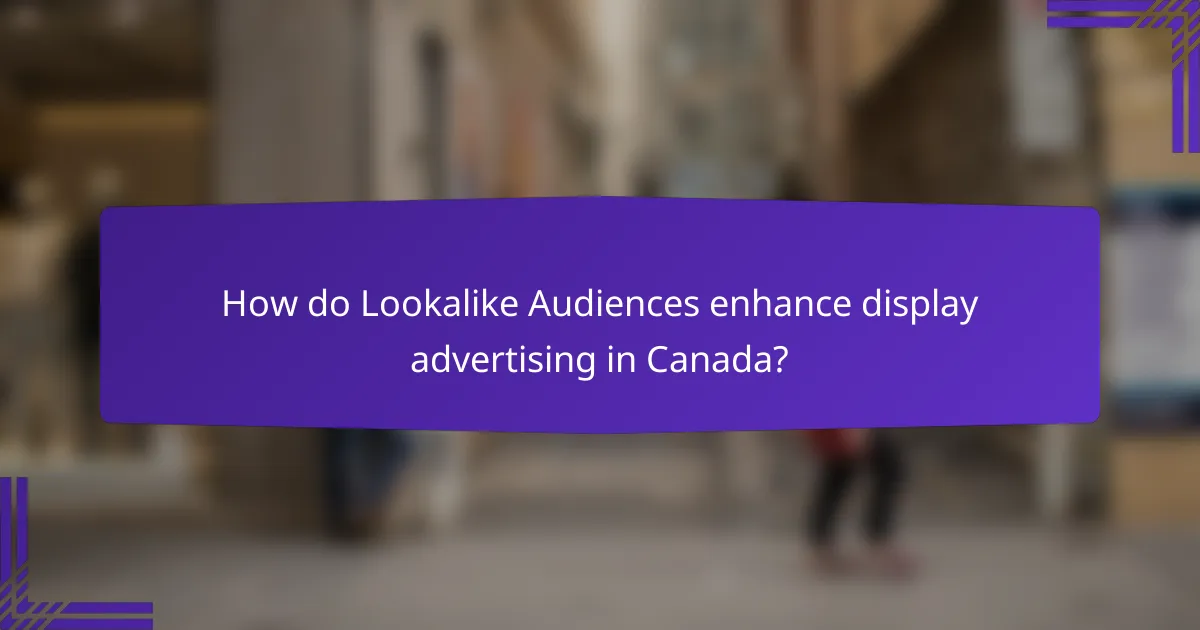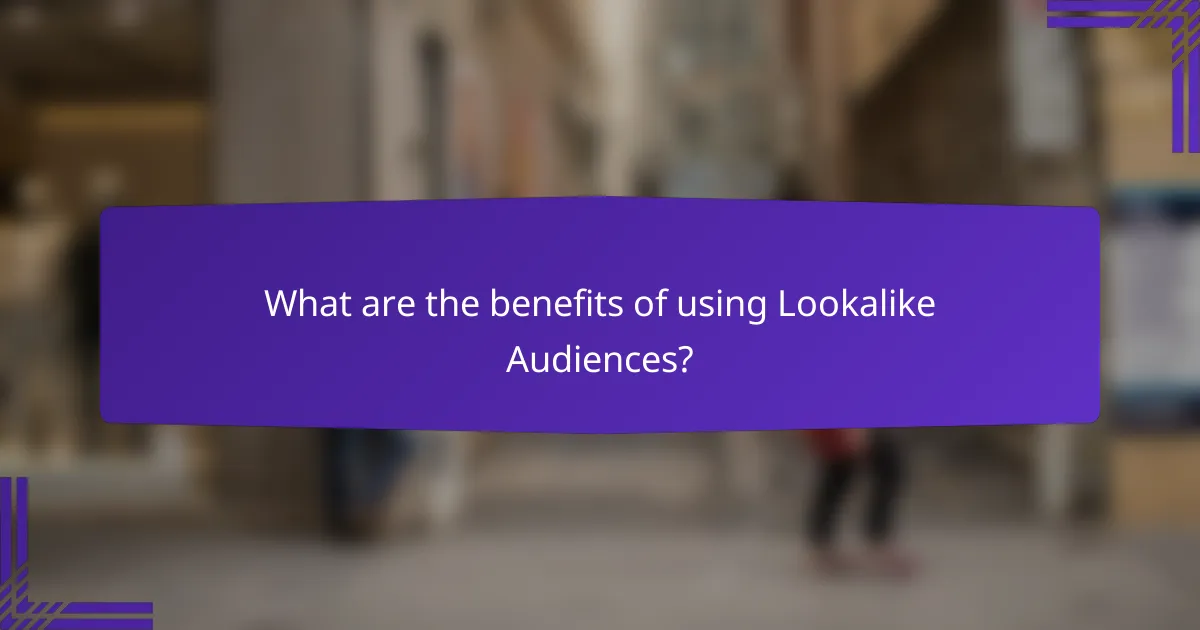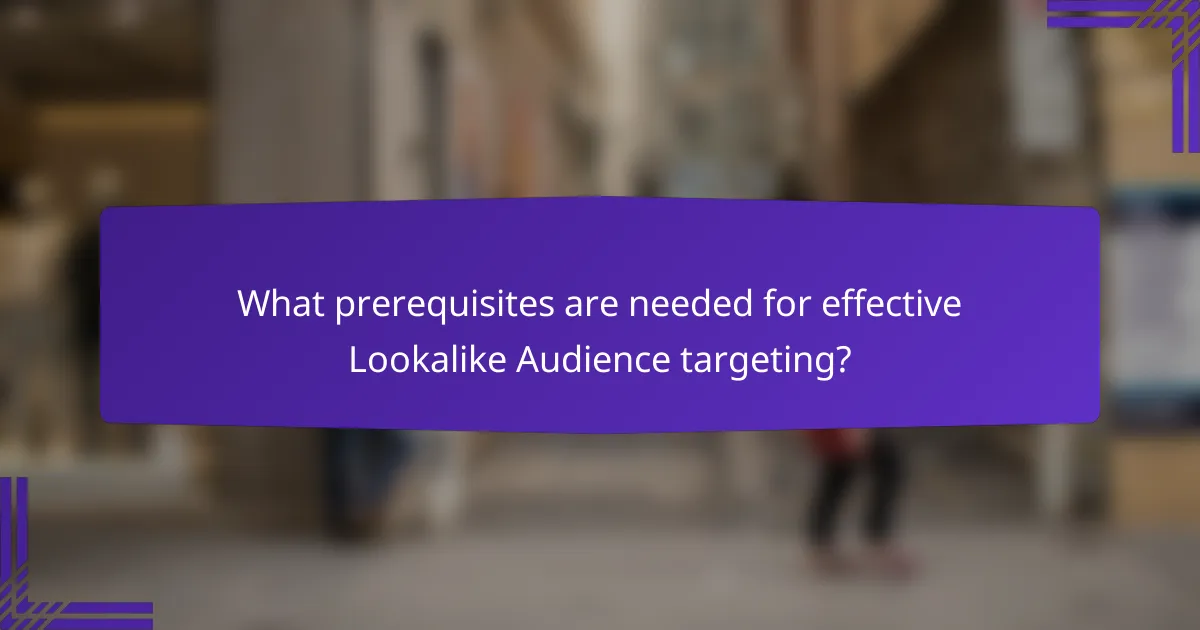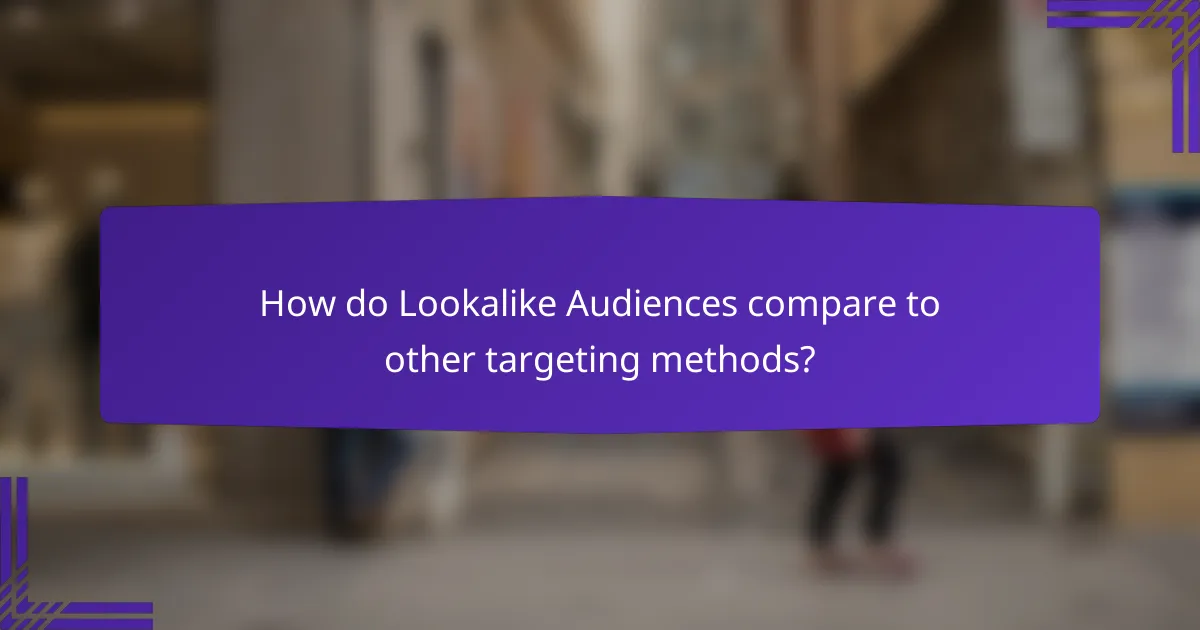Lookalike Audiences are a powerful tool for advertisers in Canada, enabling them to connect with potential customers who share similarities with their existing audience. By utilizing data from current customers, businesses can effectively expand their reach and enhance campaign effectiveness through targeted methods such as audience segmentation and demographic profiling.

How do Lookalike Audiences enhance display advertising in Canada?
Lookalike Audiences enhance display advertising in Canada by allowing advertisers to reach new customers who share similar characteristics with their existing audience. This method leverages data from current customers to identify and target potential buyers, maximizing advertising effectiveness.
Increased reach to potential customers
Using Lookalike Audiences enables advertisers to expand their reach significantly. By targeting individuals who resemble existing customers, businesses can tap into a broader market segment that may not have been previously considered.
For instance, if a company has a solid customer base in Ontario, creating a Lookalike Audience can help them find similar consumers in other provinces, increasing their overall market presence.
Improved targeting accuracy
Lookalike Audiences enhance targeting accuracy by focusing on users who exhibit behaviors and interests similar to current customers. This precision helps reduce wasted ad spend on audiences less likely to convert.
Advertisers can refine their campaigns by analyzing the attributes of their best customers, such as age, location, and purchasing habits, ensuring that their ads resonate with the right people.
Higher conversion rates
By reaching a more relevant audience, Lookalike Audiences often lead to higher conversion rates. When ads are shown to users who are more likely to be interested in the product or service, the chances of engagement and purchase increase.
For example, a retailer using Lookalike Audiences may see conversion rates rise by a notable percentage compared to traditional targeting methods, making their advertising efforts more efficient and profitable.

What are the key targeting methods for Lookalike Audiences?
Key targeting methods for Lookalike Audiences include data-driven audience segmentation, behavioral targeting techniques, and demographic profiling. These methods help marketers identify and reach new customers who resemble their existing audience, enhancing campaign effectiveness.
Data-driven audience segmentation
Data-driven audience segmentation involves analyzing existing customer data to identify patterns and characteristics that define your best customers. By leveraging analytics tools, businesses can create segments based on behaviors, preferences, and purchase history. This targeted approach ensures that Lookalike Audiences are built on solid data foundations, increasing the likelihood of engagement.
For example, an e-commerce store might segment its audience into groups such as frequent buyers, seasonal shoppers, and discount seekers. This allows for tailored marketing strategies that resonate with each segment, ultimately leading to higher conversion rates.
Behavioral targeting techniques
Behavioral targeting techniques focus on tracking user actions and interactions across digital platforms to inform audience creation. This method utilizes data from website visits, social media engagement, and email interactions to identify potential Lookalike Audiences. By understanding how users behave, marketers can refine their targeting strategies to attract similar individuals.
For instance, if a user frequently engages with travel content, a brand can target Lookalike Audiences that exhibit similar browsing habits. This increases the chances of reaching individuals who are more likely to be interested in travel-related products or services.
Demographic profiling
Demographic profiling involves analyzing characteristics such as age, gender, income, and location to define Lookalike Audiences. This method helps marketers ensure that their campaigns reach individuals who fit specific demographic criteria, which can be crucial for products or services aimed at particular groups.
For example, a luxury brand may focus on high-income individuals aged 30-50 in urban areas. By targeting Lookalike Audiences that share these demographic traits, the brand can maximize its marketing efforts and improve return on investment.

What are the benefits of using Lookalike Audiences?
Lookalike Audiences allow advertisers to target new customers who resemble their existing ones, leading to increased engagement and conversion rates. By leveraging data from current customers, businesses can effectively expand their reach and improve marketing efficiency.
Cost-effective advertising strategy
Using Lookalike Audiences is a cost-effective advertising strategy because it focuses on users who are more likely to convert based on their similarities to existing customers. This targeted approach can reduce wasted ad spend on less relevant audiences, maximizing the return on investment (ROI).
For instance, if a company spends $1,000 on ads targeting a broad audience, they might only achieve a few conversions. However, by refining their audience to lookalikes, they could potentially double their conversion rate without significantly increasing their budget.
Enhanced customer acquisition
Lookalike Audiences enhance customer acquisition by identifying potential customers who share characteristics with a business’s best existing clients. This method allows companies to tap into a pool of users who are more likely to be interested in their products or services.
For example, a fashion retailer might create a Lookalike Audience based on their top 10% of customers, leading to a higher likelihood of attracting similar buyers. This targeted acquisition can significantly increase the customer base over time.
Optimized ad spend
Optimizing ad spend with Lookalike Audiences involves allocating budget towards ads that reach the most promising prospects. By focusing on users who mirror existing customers, businesses can achieve better engagement rates and lower cost-per-acquisition (CPA).
To optimize effectively, advertisers should regularly analyze the performance of their Lookalike Audiences and adjust their targeting criteria based on real-time data. This proactive approach ensures that the advertising budget is used efficiently, maximizing the impact of each dollar spent.

What prerequisites are needed for effective Lookalike Audience targeting?
Effective Lookalike Audience targeting requires a strong foundation of quality data and seamless integration with advertising platforms. These prerequisites ensure that the audiences generated are relevant and can enhance campaign performance.
Robust source audience data
Having robust source audience data is crucial for creating effective Lookalike Audiences. This data should ideally come from your existing customers, website visitors, or engaged users, providing a clear profile of your target demographic.
Consider using data points such as purchase history, engagement metrics, and demographic information. The more comprehensive and accurate your source data, the better the Lookalike Audience will reflect your ideal customers.
Integration with advertising platforms
Seamless integration with advertising platforms like Facebook Ads or Google Ads is essential for leveraging Lookalike Audiences effectively. These platforms allow you to upload your source audience data and create Lookalike Audiences based on that information.
Ensure that you are familiar with the specific requirements of each platform, such as data format and size limits. Regularly updating your source data can also improve the accuracy of the Lookalike Audiences generated, leading to better targeting outcomes.

How do Lookalike Audiences compare to other targeting methods?
Lookalike Audiences are a powerful targeting method that allows advertisers to reach new users who resemble their existing customers. Compared to other targeting strategies, they leverage data-driven insights to expand reach effectively while maintaining relevance.
Versus Custom Audiences
Custom Audiences focus on targeting users who have already interacted with a brand, such as past customers or website visitors. In contrast, Lookalike Audiences help brands find new potential customers by analyzing the characteristics of these existing users and identifying similar individuals.
While Custom Audiences are effective for re-engagement, Lookalike Audiences can significantly broaden a brand’s reach. For example, if a company has a strong customer base in the U.S., creating a Lookalike Audience can help tap into similar users across various states, increasing the chances of acquiring new customers.
Versus Interest-based targeting
Interest-based targeting allows advertisers to reach users based on their expressed interests, behaviors, or demographics. Lookalike Audiences, however, utilize existing customer data to find new users who share similar traits, potentially leading to higher conversion rates.
Interest-based targeting can be broad and less precise, while Lookalike Audiences are more focused and data-driven. For instance, a fitness brand using interest-based targeting might reach anyone interested in health, but a Lookalike Audience would specifically target users who resemble their most loyal customers, enhancing the likelihood of engagement.

What emerging trends are shaping Lookalike Audience strategies?
Emerging trends in Lookalike Audience strategies are increasingly influenced by advancements in technology and evolving privacy regulations. Brands are leveraging AI-driven insights and adopting privacy-focused targeting methods to enhance their audience reach while ensuring compliance with data protection laws.
AI-driven audience insights
AI-driven audience insights utilize machine learning algorithms to analyze existing customer data and identify patterns that can help in creating effective Lookalike Audiences. These insights allow marketers to pinpoint characteristics of high-value customers, enabling them to target similar users more accurately.
For example, platforms like Facebook and Google use AI to analyze user behavior and preferences, which can lead to more precise audience segmentation. Businesses can expect improved engagement rates by focusing on these data-driven insights, often resulting in a higher return on investment.
Privacy-focused targeting approaches
Privacy-focused targeting approaches prioritize user consent and data protection, aligning with regulations like GDPR in Europe and CCPA in California. Marketers are shifting towards first-party data collection methods, which involve gathering information directly from users through opt-in forms and loyalty programs.
Implementing these approaches can enhance trust with customers while still allowing for effective targeting. Brands should ensure transparency in how they collect and use data, as this can significantly impact customer relationships and brand loyalty. Avoiding reliance on third-party cookies is a key strategy in this evolving landscape.
